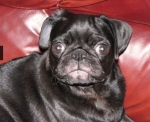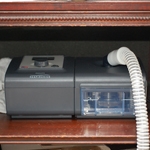Hey Morbius...if you are still hanging around (hope you are) would you please take a look here
https://www.cpaptalk.com/viewtopic.php? ... 0#p1405450
and offer your wisdom.
I would greatly appreciate it.
Thank you.
Does a sleep study HAVE to show AHI greater than 5 to warrant cpap use?
Re: Does a sleep study HAVE to show AHI greater than 5 to warrant cpap use?
_________________
| Machine: AirCurve™ 10 VAuto BiLevel Machine with HumidAir™ Heated Humidifier |
| Additional Comments: Mask Bleep Eclipse https://bleepsleep.com/the-eclipse/ |
I may have to RISE but I refuse to SHINE.
- SleepyCPAP
- Posts: 333
- Joined: Wed Dec 08, 2010 6:01 am
Re: Does a sleep study HAVE to show AHI greater than 5 to warrant cpap use?
OK,
So if I understand correctly, WSCS is Wisconsin Sleep Cohort Study
And SHHS is Sleep Heart Health Study
Yes, I remember the 6% stroke risk increase for each 1 AHI increase.
Sadly, I have not constructed a “WSCS” folder on my drive. Perhaps you are referring to someplace on the web where it exists? But searching my drive for “Wisconsin” did show up in a “Rebuttal from Drs Collop and Berry” at the end of the “Point and Counterpoint” editorial within the August 2021 CHEST journal (160 #2, this letter is at pp.420-421), in which they agreed on the point of “AHI is a very imperfect tool.”
So if I understand correctly, WSCS is Wisconsin Sleep Cohort Study
And SHHS is Sleep Heart Health Study
Yes, I remember the 6% stroke risk increase for each 1 AHI increase.
Sadly, I have not constructed a “WSCS” folder on my drive. Perhaps you are referring to someplace on the web where it exists? But searching my drive for “Wisconsin” did show up in a “Rebuttal from Drs Collop and Berry” at the end of the “Point and Counterpoint” editorial within the August 2021 CHEST journal (160 #2, this letter is at pp.420-421), in which they agreed on the point of “AHI is a very imperfect tool.”
More pertinent to this thread topic is the conclusion statement of their letter, including a slew of suggestions for other measurements:“We never suggested that the AHI alone should be used in isolation to diagnose sleep apnea; our argument revolves around trying to use the AHI metric to make treatment available to patients who may benefit.”
And yes, morbius, the rebuttal is to a letter that said (same page)The field clearly should be searching beyond this metric to determine what will improve our ability to predict outcomes better in patients with OSA. Studies that have addressed this are examining variables like the length of events, the depth of oxygen desaturation, the presence of expiratory flow limitation, arousal intensity, heart rate variability, analysis of inspiratory flow limitation, EEG characteristics such as K-complexes, and sleep spindles, to name a few. [6-9] To further complicate this, most of the patients currently are diagnosed with a less sophisticated home sleep apnea test, which in fact limits our ability to look at other potentially important variables in our diagnostic algorithm. Advancing the field beyond the AHI will require the improvement of both polysomnography techniques and our home sleep apnea tests to identify signals that can be applied easily and quantitated.
- SleepyCPAPWe should keep arousals, respiratory event-related arousals, and the respiratory disturbance index in the the research realm until we know what to do (if anything) about them.
_________________
| Machine: AirCurve™ 10 VAuto BiLevel Machine with HumidAir™ Heated Humidifier |
| Mask: Bleep DreamPort CPAP Mask Solution |
| Additional Comments: Use OSCAR. Combine AlaxoStent with VAuto for perfect 0.0 AHI at PS 3.6 over 4cm EPAP |
-- SleepyCPAP
Sleep study in 2010 (11cm CPAP). Pillows (Swift FX>TAP PAP >Bleep). PRS1 “Pro” 450/460 until recall, now Aircurve 10 VAuto. Tape mouth. Palatal Prolapse solved by AlaxoStent & VAuto EPAP 4cm, PS 3.6cm = 0.0 AHI
Sleep study in 2010 (11cm CPAP). Pillows (Swift FX>TAP PAP >Bleep). PRS1 “Pro” 450/460 until recall, now Aircurve 10 VAuto. Tape mouth. Palatal Prolapse solved by AlaxoStent & VAuto EPAP 4cm, PS 3.6cm = 0.0 AHI
Re: Does a sleep study HAVE to show AHI greater than 5 to warrant cpap use?
Silly me!SleepyCPAP wrote: ↑Wed Feb 09, 2022 10:41 amSadly, I have not constructed a “WSCS” folder on my drive.
It's in my folder!
https://www.nejm.org/doi/full/10.1056/n ... 5113421901
Re: Does a sleep study HAVE to show AHI greater than 5 to warrant cpap use?
I'm not understanding what your point is.SleepyCPAP wrote: ↑Wed Feb 09, 2022 10:41 amBut searching my drive for “Wisconsin” did show up in a “Rebuttal from Drs Collop and Berry” at the end of the “Point and Counterpoint” editorial within the August 2021 CHEST journal (160 #2, this letter is at pp.420-421), in which they agreed on the point of “AHI is a very imperfect tool.”More pertinent to this thread topic is the conclusion statement of their letter, including a slew of suggestions for other measurements:“We never suggested that the AHI alone should be used in isolation to diagnose sleep apnea; our argument revolves around trying to use the AHI metric to make treatment available to patients who may benefit.”And yes, morbius, the rebuttal is to a letter that said (same page)The field clearly should be searching beyond this metric to determine what will improve our ability to predict outcomes better in patients with OSA. Studies that have addressed this are examining variables like the length of events, the depth of oxygen desaturation, the presence of expiratory flow limitation, arousal intensity, heart rate variability, analysis of inspiratory flow limitation, EEG characteristics such as K-complexes, and sleep spindles, to name a few. [6-9] To further complicate this, most of the patients currently are diagnosed with a less sophisticated home sleep apnea test, which in fact limits our ability to look at other potentially important variables in our diagnostic algorithm. Advancing the field beyond the AHI will require the improvement of both polysomnography techniques and our home sleep apnea tests to identify signals that can be applied easily and quantitated.- SleepyCPAPWe should keep arousals, respiratory event-related arousals, and the respiratory disturbance index in the the research realm until we know what to do (if anything) about them.
Or if it's an agreement or a counter to one of my points.
- SleepyCPAP
- Posts: 333
- Joined: Wed Dec 08, 2010 6:01 am
Re: Does a sleep study HAVE to show AHI greater than 5 to warrant cpap use?
Thanks for the link. Yes, this was the study I read about the health risk factors rising even starting at 0.1 AHI.Morbius wrote: ↑Wed Feb 09, 2022 11:20 am
Silly me!
It's in my folder!
https://www.nejm.org/doi/full/10.1056/n ... 5113421901
Thank you morbius.Relative to the reference category of an apnea–hypopnea index of 0 events per hour at base line, the odds ratios for the presence of hypertension at follow-up were 1.42 (95 percent confidence interval, 1.13 to 1.78) with an apnea–hypopnea index of 0.1 to 4.9 events per hour at base line as compared with none, 2.03 (95 percent confidence interval, 1.29 to 3.17) with an apnea–hypopnea index of 5.0 to 14.9 events per hour, and 2.89 (95 percent confidence interval, 1.46 to 5.64) with an apnea–hypopnea index of 15.0 or more events per hour.
- SleepyCPAP
_________________
| Machine: AirCurve™ 10 VAuto BiLevel Machine with HumidAir™ Heated Humidifier |
| Mask: Bleep DreamPort CPAP Mask Solution |
| Additional Comments: Use OSCAR. Combine AlaxoStent with VAuto for perfect 0.0 AHI at PS 3.6 over 4cm EPAP |
-- SleepyCPAP
Sleep study in 2010 (11cm CPAP). Pillows (Swift FX>TAP PAP >Bleep). PRS1 “Pro” 450/460 until recall, now Aircurve 10 VAuto. Tape mouth. Palatal Prolapse solved by AlaxoStent & VAuto EPAP 4cm, PS 3.6cm = 0.0 AHI
Sleep study in 2010 (11cm CPAP). Pillows (Swift FX>TAP PAP >Bleep). PRS1 “Pro” 450/460 until recall, now Aircurve 10 VAuto. Tape mouth. Palatal Prolapse solved by AlaxoStent & VAuto EPAP 4cm, PS 3.6cm = 0.0 AHI
- SleepyCPAP
- Posts: 333
- Joined: Wed Dec 08, 2010 6:01 am
Re: Does a sleep study HAVE to show AHI greater than 5 to warrant cpap use?
Not a counter to your previous post about eliminating RERA’s. I meant to include this last quote as evidence that yes others point to that too. Sorry I did not include that commentary.
The bulk of my response was to add more to the thread topic of what a sleep study “has” to show to warrant CPAP use. It is clear that the main drift of the Editorial conversation in that journal issue was around “how to score Hypopneas” and “who does that leave out who might benefit from diagnosis/treatment?”, but the part I quoted was to point out these researchers believe screening (and effective treatment) should go beyond that metric. There are so many possible considerations.
Sorry for any confusion.
1. Why do these studies matter to me? 2. Why does the <5AHI cutoff, in particular, matter in my case?
1: I look at these studies because I need to be very careful with the stresses on my body. The number of medical conditions has escalated for me in recent years. Despite normal BMI, keeping active with exercise, and not being a senior citizen. For a decade+ CPAP used to be well managed too, and then starting this summer it wouldn’t work, which meant I was no longer mostly <1 AHI, and I’m suspecting this was a piece of the puzzle. In the midst of AHI going haywire, I had a heart attack. I’ve managed to wrestle my sleep apnea therapy back to being a majority of 0.0 AHI nights, with OSCAR telling me my FL is near zero too (0.03 last night, 99.5th%). I needed to add the AlaxoStent to get there, propping open my soft palate, combined with BiLevel for its focus on eliminating FL and ability to give more pressure support. When I see a study saying I may have cut my risks for cardiovascular system problems by maintaining zero AHI, it helps emotionally.
2: Because my sleep doctor’s office used that 5 AHI line with me. My attainment of better numbers is praised, but there are far more patients they have to attend to (I’m guessing who are not adjusting to therapy or getting <5 AHI). The cut-off made it, in my opinion, so that I was looking like someone who was “fine”.
- SleepyCPAP
_________________
| Machine: AirCurve™ 10 VAuto BiLevel Machine with HumidAir™ Heated Humidifier |
| Mask: Bleep DreamPort CPAP Mask Solution |
| Additional Comments: Use OSCAR. Combine AlaxoStent with VAuto for perfect 0.0 AHI at PS 3.6 over 4cm EPAP |
-- SleepyCPAP
Sleep study in 2010 (11cm CPAP). Pillows (Swift FX>TAP PAP >Bleep). PRS1 “Pro” 450/460 until recall, now Aircurve 10 VAuto. Tape mouth. Palatal Prolapse solved by AlaxoStent & VAuto EPAP 4cm, PS 3.6cm = 0.0 AHI
Sleep study in 2010 (11cm CPAP). Pillows (Swift FX>TAP PAP >Bleep). PRS1 “Pro” 450/460 until recall, now Aircurve 10 VAuto. Tape mouth. Palatal Prolapse solved by AlaxoStent & VAuto EPAP 4cm, PS 3.6cm = 0.0 AHI










